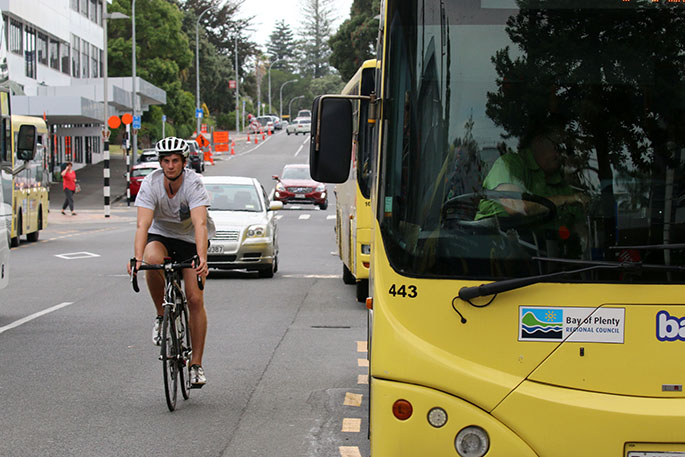The Bay of Plenty Regional Land Transport Plan has been adopted by the Regional Council.
The RLTP sets out a ten-year sustainable transport strategy proposing $2.5 billion of investment in the region over the next six years.
Highlights of the RLTP include proposed investment in multi-modal transport activities including public transport, cycling and road safety.
There is also strong support for providing transport infrastructure and services to assist new development in the major urban areas of Tauranga, Rotorua and Whakatāne.
Regional Transport Committee chairman Lyall Thurston says the RLTP aligns closely with central government priorities and takes a system-wide approach to delivering transport investment.
'This approach entails investment to deliver compact, liveable and safe communities, where a choice of travel is available," says Lyall.
'There are significant pressures on the National Land Transport Programme budgets and the Bay of Plenty region must make a strong case for more effective transport solutions to meet our community aspirations."
Lyall says in many cases, this will involve reducing the need to travel and through better decision-making concerning where new development is located.
'The region has different problems to tackle with the western Bay undertaking recent strategic activity initiatives.
'As a result, councils across the sub-region now have a 30-year vision and outline programme of investment to address the growth challenges," says Lyall.
'Collaboration between the Western Bay councils, Waka Kotahi and iwi has been significantly enhanced through this work, and this RLTP sets out several priority activities which we would like to progress in partnership.
'Similarly in Rotorua and the Eastern Bay, councils are working collaboratively in the transport space both to tackle a range of deep-seated accessibility issues and address the more recent challenges of COVID-19," says Lyall.
One proposal in the Eastern Bay is improving Keepa Road between State Highway 30 and the Kopeopeo East Canal Bridge to cater for surrounding changes in land use.
A safety improvement package for SH5 South Rotorua has also been proposed.
Lyall says transport infrastructure is becoming increasingly vulnerable to the natural impacts of climate change; and that the role of maintenance and asset management is crucial in keeping the Bay of Plenty open for business.
"The Regional Transport Committee is grateful to iwi, council partners, Waka Kotahi and key stakeholders, including the Port of Tauranga and the Police, for their assistance in putting the plan together," says Lyall.



6 comments
So the spin continues
Posted on 26-06-2021 07:44 | By Kancho
I expect I lot of disruption and travel time increases. Public transport may eventually become viable for some but unlikely to suit the majority. Walking and carrying and going to several places is not possible . Nor is working in different locations Buses can never go everywhere. Guess we will find out how many people just do one journey to work and return and how many bus changes . I do two just to get to the hospital and takes at least twice as long and very unpleasant in poor weather
Virtue signalling for no gain
Posted on 26-06-2021 09:38 | By Let's get real
As everyone that has travelled beyond our shores knows, even when a city has a population large enough to support public transport, most people use their own transport and as much as they would like people to change, it's never going to happen because people don't want to be near people that they don't know. So even if thousands more buy electric vehicles, we're still going to have private vehicles on the roads and NOT bicycles or full public transport. Why do local authorities believe that a national population smaller than a small city overseas is going to be any different. We need (not want) safe roading systems that work properly.
The present government...
Posted on 26-06-2021 15:02 | By morepork
... has shown that they dislike motorists and they are listening to whispers from Greens who have tunnel vision. Whether it is organic fuel or electricity, the majority of the population rely on cars to take them where and when they want to go. Bikes have a place, but they cannot dictate the use of roads. That is Reality, and its time that environment friendly cars and buses were recognized as NOT needing replacement by bicycles. We should be using smaller, more agile, and cheaper to buy and run buses, and it isn't rocket science to see that, but nobody has the will or ability to do what is needed. The Community would be much better served with a fleet of eco-friendly minibuses, than the great lumbering buffalo buses that are always empty and a menace to pedestrians and traffic alike.
Why not just...
Posted on 26-06-2021 15:23 | By morepork
... give every household in the Bay their split on the 2.5 billion ($22,538.98) and we can all take Ubers for the next 10 - 15 years...
Am I surprised?
Posted on 27-06-2021 13:32 | By Ceem
Probably the second most important highway (SH2) in New Zealand has once again been ignored for upgrading to true highway status. While safety upgrades are necessary in some places, not all, road funding is being frittered away just to show NZTA and Regional Councils are doing something albeit road dressing.
Read Simon Wilson's article in herald today
Posted on 28-06-2021 09:48 | By Kancho
Title: "Transport plan with true emissions goal ? Forget it " Quote " Auckland Transport has conflated spending on public transport on climate change. It may seem logical more buses, trains and ferries means more people riding them , so fewer cars , right? Wrong. Auckland has had strongly rising rates of public transport use for a decade, but emissions have also risen. The reason population growth"
Leave a Comment
You must be logged in to make a comment.